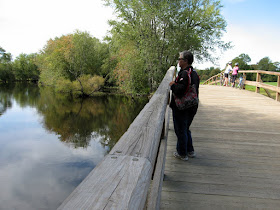After our long day in Beantown yesterday, we drove up to a quaint little fishing/lobster village. I had been to Newburyport before, many years ago on official business for the Navy. It is about 20 miles below Poertsmouth, Nh and has a nice little town center that town folks are proud of. We went into the starbucks across the street from here and plopped ourselves down on one of these benches and just relaxed. Note below that one of the little dogs in the distance has wheels for back legs. I guess it was paralyzed, but it seemed to get along just fine, including down the curb. We had lunch at the Black Cow restaurant, right on the wharf overlooking the working fleet as well a gaggle of pleasure boats.
After lunch we decided to take 1A south from here and head towards Salem. Now I don't know much about Salem, but I do know that way back in 1692 I had a very, very distant relative hung. That's right! Hung, by the neck! Martha Carrier was accused and convicted for being a witch. Years later it was concluded that the twon may have acted to quickly and perhaps even in error about all the hub bub about the Salem witchcraft trials of that era. Kathleen Kent even wrote historical novels of those events and one of her publications even made the best seller lists. We visited the museum there. Above and below are a few pics of our visit.
Above shows the "hung" list, and just below that is part of the list of "accused" list.
Less than two blocks from the museum, is the cemetery where all the "hung" were buried. I think there were about 20 folks hung that day. One section has all the plots where they were interred. Above and below is Martha's burial site. Place gives me the willies.
So, high-tailed it out of Salem and drove a few miles to Saugus. Here we ran into a neat National Historic Landmark called Saugus Iron Works. From Wiki: Located about 10 miles (16 kilometers) northeast of Downtown Boston in Saugus, Massachusetts is the site of the first integrated ironworks in North America, 1646 – 1668. It includes the reconstructed blast furnace, forge, rolling mill, shear, slitter and a quarter-ton drop hammer. The facility is powered by seven large waterwheels, some of which are rigged to work in tandem with huge wooden gears connecting them. It has a wharf to load the iron onto ocean-going vessels, as well as a large, restored 17th-century house.
The waterwheel in action above. Below the giant belows powered by the wheel drive.
Below is the drain for the molten raw iron that merely settles into the sand furrows. After they cool they are then taken to the next refinement stage next door.
Above, some of tools of the trade. Below is the giant hammer used to shape the large near-molten iron. The hammer is powered also by the wheel drive system.
Below is one of the refinement furnaces.
Above and below are the set of "squeeze-rollers used to flatten, dice and otherwise shape the refined rods of iron into shapes that can be used by the New England pioneers for various construction projects of the time.
Above are a few items that were produced by the Works. Below is a ranger actually making nails from one of the rods from the refinement process.
Above is a short clip, which I don't normally include because they are "byte hogs" on bandwidth. I took several videos of this process, included about a 90 second clip on the nail-making, but include this one only so you get a feel for clank-clank that the skilled laborours endured day after day ploying their trades.
Before we left the next day, we got up early and drove into Minute Man National Historical Park. From Wiki: Minute Man National Historical Park commemorates the opening battle in the American Revolutionary War. It also includes The Wayside, home in turn to three noted American authors. The National Historical Park is under the jurisdiction of the National Park Service and protects 970 acres (3.9 km2) in and around the towns of Lexington, Massachusetts, Lincoln, Massachusetts, and Concord, Massachusetts. We did make it into the visitor's center and watched the 20 minute video, and then drove on into Concord, a neat little village with several nice structures.
Below, the main drag thru Concord.
Above and below are a few pics from where the first british were killed near the "end of Paul Revere's ride".
Below, the North Bridge, where on April 19, 1775, colonial commanders ordered militia men to fire back at British troops for the first time. British colonial militia and minutemen killed three regular army soldiers and wounded eight at the North Bridge Fight.
Above, Miss Nancy posing on the bridge near where the "shot heard round the world" was coined by Ralph Waldo Emerson, who lived nearby at the time.
Below is Nancy posing with a Yankee regular and a Redcoat. Boo!
So, ths ends our time around the Boston area. We drove back to the FamCamp at Hanscom around noon and headed out to Maine and Acadia NP. And that will be the topic of our next blog. Till then, RVing Beach Bums.




































No comments:
Post a Comment